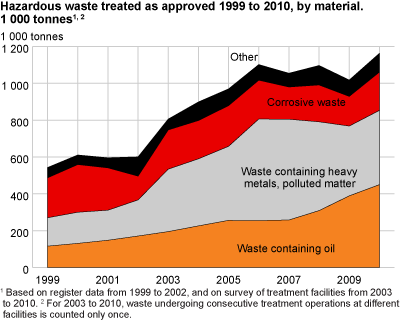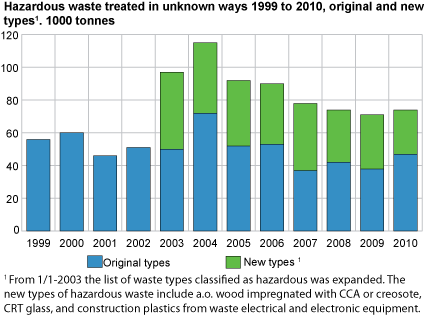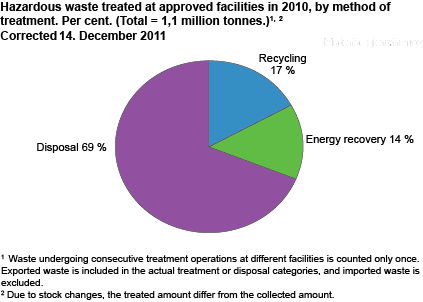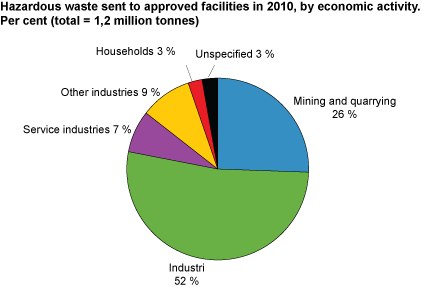Content
Published:
This is an archived release.
More hazardous waste in 2010
A total of 1.2 million tonnes of hazardous waste were sent for approved treatment in 2010; up 14 per cent from the previous year. Of this, 450 000 tonnes were made up of oil-containing waste. Since 1999, the amount of hazardous waste has increased by 114 per cent.
Improved collection and reporting are assumed to be the main reasons for this increase. Furthermore, some waste types have been reclassified as hazardous during the period.
Oil-containing waste dominates
A total of 450 000 tonnes of oil-containing waste were collected in 2010, rendering this fraction the most abundant in Norway. Recalculating into pure oil, this fraction contains 43 000 tonnes of lubricant oil, in addition to crude oil and fuel oil. The total includes 246 000 tonnes of oil-drilling waste from offshore activities, which rose by 85 per cent from the previous year. The rise was mainly due to technical problems obstructing the reinjection of waste into the wells.
Waste containing heavy metals and polluted mineral matters increased, following a fall in the preceding two years. This waste type comprised 400 tonnes in 2010, of which the major component was slag from manufacturing.
94 per cent treated at approved facilities
Ninety-four per cent of hazardous waste was treated at approved facilities, according to estimations. This was up 1 per cent from the previous year. Thirty-one per cent1 of the waste treated as approved was recycled, while 69 per cent were disposed of, mainly at specially-designed landfills. Treatment abroad is included in these figures, but stock changes are not.
The amount handled in unknown ways was about 2 000 tonnes higher than in 2009. The main reason is an increase of 10 000 tonnes in the unknown handling of oil-containing waste, which in turn is a result of less oil-containing waste being collected for approved treatment from activities other than oil extraction. On the other hand, for EE-waste and creosote impregnated wood, the amount of unknown handling dropped by about 5 000 and 2 000 tonnes respectively. There has been a long-term drop in the amount of unknown handling since the peak in 2004.
More transboundary shipments
Norway received 380 000 tonnes of hazardous waste from foreign countries in 2010, up 39 per cent from the previous year. Concurrently, the exported amount increased by 13 per cent to 170 000 tonnes. The import is dominated by waste containing heavy metals and polluted mineral matter destined for landfilling. The increase in exported amounts is mainly due to organic waste types, such as creosote impregnated wood and plastics with brominated flame retardants or phthalates. Multilateral cooperation allows sound, specialised treatment of the different types of hazardous waste.
Nevertheless, 85 per cent of the hazardous waste generated in Norway was treated domestically.
Manufacturing industries sent 612 000 tonnes of hazardous waste to approved treatment, which comprises more than half of the total. Mining and quarrying, which includes oil extraction, accounted for a quarter.
Less hazardous waste from Svalbard
About 100 to 300 tonnes of hazardous waste is shipped to the mainland each year, and has been rather low for the past two years. More than half is made up of oil-containing waste. The amount in 2010 was 120 tonnes.
Tables:
- Table 1 Hazardous waste sent to approved facility 1999 to 2010, by material. 1 000 tonnes.
- Table 2 Hazardous waste to unknown handling 1999 to 2010, by material. 1 000 tonnes.
- Table 3 Hazardous waste treated as approved and handled in unknown ways in 1999 to 2010, total and new types. 1 000 tonnes
- Table 4 Hazardous waste sent to approved facility 2003 to 2010, by method of treatment. 1 000 tonnes
- Table 5 Hazardous waste sent to approved facility 1999 to 2010, by economic activity. 1 000 tonnes
Additional information
Approved treatment as applied in this article includes only hazardous waste generated in Norway (export is therefore included, while import is excluded).
Contact
-
Gisle Berge
E-mail: gisle.berge@ssb.no
tel.: (+47) 48 12 19 97
-
Terje Lorentzen Landsem
E-mail: terje.landsem@ssb.no
tel.: (+47) 98 84 31 39




